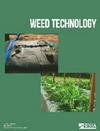用甲氧丙酸酯和莠去津加草除草剂防治玉米杂草
IF 1.7
3区 农林科学
Q3 AGRONOMY
引用次数: 0
摘要
2021年和2022年,在安大略省西南部进行了六项田间试验,以评估在甲吡甲酸盐+阿特拉津中添加草除草剂(乙草胺、二甲胺-p、氟英塞、对二甲胺、pyroxasulfone或s -甲草胺)是否能改善玉米的季末杂草控制。在施用除草剂后1周和4周,甲吡甲酸酯+阿特拉津分别对玉米造成12%和5%的伤害;禾草除草剂的添加没有增加玉米的伤害。杂草影响使玉米产量降低60%。在甲吡甲酸酯+阿特拉津的基础上添加一种草除草剂,对丝叶病的防治效果不明显。甲氧苄酯+阿特拉津中加入乙草胺或二甲胺-p,可增强对4% 4 WAA的杂草控制;添加其他草除草剂并没有增加对藜草种类的控制。在4 WAA条件下,乙草胺对豚草的防治效果为5%;在8 WAA条件下,乙草胺或二甲胺-p对豚草的防治效果为8%;添加其他草除草剂对普通豚草的控制没有改善。在甲吡甲酸酯+阿特拉津的基础上添加乙草胺,可使常见的羔羊窝控制率提高4%;添加其他禾草除草剂对普通羔羊窝的控制没有增强作用。4和8 WAA时,甲吡甲酸酯+阿特拉津对稗草的防效分别为90%和78%;在4 WAA和8 WAA条件下,添加草除草剂对稗草的防治效果分别为9 ~ 10%和21%。在4和8 WAA时,甲吡甲酸酯+阿特拉津对绿尾狐和巨尾狐的抑制率分别为80%和69%;在4 WAA和8 WAA条件下,添加一种草除草剂分别提高了15 ~ 19%和24 ~ 29%的鼠尾草种类控制。本研究表明,在甲吡甲酸酯+阿特拉津混合液中添加一种草除草剂可以提高杂草防治效果,特别是增加玉米生产的年草防治效果。本文章由计算机程序翻译,如有差异,请以英文原文为准。
Weed control in corn with tolpyralate and atrazine plus grass herbicides
Six field experiments were established in southwestern Ontario in 2021 and 2022 to evaluate if the addition of a grass herbicide (acetochlor, dimethenamid-p, flufenacet, pendimethalin, pyroxasulfone, or S-metolachlor) to tolpyralate + atrazine improves late-season weed control in corn. Tolpyralate + atrazine caused 12% and 5% corn injury at 1 and 4 weeks after herbicide application (WAA); corn injury was not increased with the addition of a grass herbicide. Weed inference reduced corn yield 60%. The addition of a grass herbicide to tolpyralate + atrazine did not enhance velvetleaf control. The addition of acetochlor or dimethenamid-p to tolpyralate + atrazine enhanced pigweed species control 4% 4 WAA; the addition of other grass herbicides tested did not increase pigweed species control. The addition of acetochlor enhanced common ragweed control 5% at 4 WAA and the addition of acetochlor or dimethenamid-p enhanced common ragweed control 8% at 8 WAA; the addition of other grass herbicides did not improve common ragweed control. The addition of acetochlor to tolpyralate + atrazine enhanced common lambsquarters control up to 4%; there was no enhancement in common lambsquarters control with the addition of the other grass herbicides. Tolpyralate + atrazine controlled barnyardgrass 90% and 78% at 4 and 8 WAA, respectively; the addition of a grass herbicide enhanced barnyardgrass control 9 to 10% and 21% at 4 and 8 WAA, respectively. Tolpyralate + atrazine controlled green or giant foxtail 80% and 69% at 4 and 8 WAA, respectively; the addition of a grass herbicide enhanced foxtail species control 15 to 19% and 24 to 29% at 4 and 8 WAA, respectively. This research shows that adding a grass herbicide to tolpyralate + atrazine mixture can improve weed control efficacy, especially increased annual grass control in corn production.
求助全文
通过发布文献求助,成功后即可免费获取论文全文。
去求助
来源期刊

Weed Technology
农林科学-农艺学
CiteScore
2.90
自引率
21.40%
发文量
89
审稿时长
12-24 weeks
期刊介绍:
Weed Technology publishes original research and scholarship in the form of peer-reviewed articles focused on understanding how weeds are managed.
The journal focuses on:
- Applied aspects concerning the management of weeds in agricultural systems
- Herbicides used to manage undesired vegetation, weed biology and control
- Weed/crop management systems
- Reports of new weed problems
-New technologies for weed management and special articles emphasizing technology transfer to improve weed control
-Articles dealing with plant growth regulators and management of undesired plant growth may also be accepted, provided there is clear relevance to weed science technology, e.g., turfgrass or woody plant management along rights-of-way, vegetation management in forest, aquatic, or other non-crop situations.
-Surveys, education, and extension topics related to weeds will also be considered
 求助内容:
求助内容: 应助结果提醒方式:
应助结果提醒方式:


